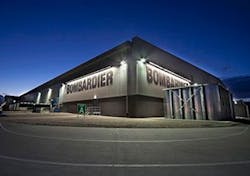MONTREAL, 7 Dec. 2013. Industry, government, and academia join forces under the Consortium for Research and Innovation in Aerospace in Quebec (CRAIQ) and SAGE (Safe, Affordable, Green, Efficient) to solve current and future aerospace challenges.
The Consortium for Research and Innovation in Aerospace in Quebec (CRAIQ) was founded in 2002 to accelerate collaborative research and development (R&D) between companies, universities, and research centers. One area of focus is aerospace.
The business-led consortium operates under a two-plus-two model, whereby a minimum of two companies and two universities collaborate on precompetitive research at the low end of the Technical Readiness Level (TRL) scale. The money goes to the universities, but the projects always come from industry companies, explains Clement Fortin, president and CEO of CRAIQ in Montreal.
CRIAQ is non-profit and owns no intellectual property (IP), says Fortin. “We facilitate and fund some of the research. It’s a classic funding model: We give 25 percent, partners contribute 25 percent, and the government matches with a 50 percent contribution. It cost much less to do R&D here,” Fortin says of Canada. “It’s a different model.”
“A group of people from industry work with researchers to help build and develop the project,” Fortin says. “It is a collaborative think tank of R&D [that provides] many advantages for companies.” CRAIQ staff is officially signing 100 projects this week.
“CRIAQ has allowed university professors to know about our problems. We learn to collaborate from CRIAQ. There is home for curiosity research, to push the envelope, but [there is also a drive for researchers] to use [their] knowledge to help us [in industry],” describes Fassi Kafyeke, director of strategic technology at Bombardier and chairman of the board of directors and of the executive committee of SAGE, Canada’s coalition for greener aircraft.
SAGE provides a collaborate space to help bring technologies much closer to market; SAGE work is at a higher TRL than that of CRIAQ, Fortin clarifies. Both entities share the goals of training highly qualified personnel for the industry and increasing the competitiveness of the aerospace sector in Montreal, Quebec, and Canada (at the city, providence, and national levels). They help to bridge gaps between companies and technologies, adds Fortin. Industry companies have to invest time and effort, but it helps graduate students know about real-world concerns and brings researchers much closer to industry, he says.
As an example, aerospace firms Bombardier, Bell Helicopter, and Delastek (a Canada-based maker of aerospace composite materials, including the cockpit panels on Bombardier’s CSeries), are working with local universities on a project to evaluate the cost vs. performance of composite materials. The work is in process, but they are achieving concrete results and finding out what works and what doesn’t work, Fortin describes.
“New technology starts with good ideas,” Kafyeke says, “typically at university, and takes three to five years to mature. Once ideas are brought to certain point, you have to increase the technology readiness” and prove that they work in relevant applications by way of small demonstrator programs.
“You need a program to take all these ideas and do the extra step to enable us to commercialize them. We call this SAGE, which means advanced environmental systems for airplanes. It is a five-year, $150 million program to which government contributed $70 million and industry provided $80 million to “take promising technologies and bring them to fruition for demonstration,” Kafyeke says. (Six main companies—Bell Helicopter, Bombardier, Pratt & Whitney, Thales, CMC, and Héroux-Devtek (maker of aircraft landing gear)—put roughly 50 percent of the money into SAGE.)
SAGE projects and participants anticipate coming industry challenges, including globalization and the environment. “The fact is there are a lot more companies around the world that want to make airplanes, such as China, Korea, and Japan,” Kafyeke admits. “We [in Canada] need to meet that challenge.” At the same time, he says, “We are concerned about climate change and the production of manmade carbon in the atmosphere; aerospace is responsible for two to three percent annually. We want to be proactive.”
To cut carbon emissions in half by 2050, we need “more efficient airplanes, biofuels, improvements in air traffic control to reduce delays when you’re just burning fuel for nothing,” Kafyeke insists. “It’s not a fad. It’s very important. When you look at globalization, in the future if you want to sell airplanes, you will have to be better, differentiated. We believe the differentiator will be how good your plane is in terms of environmental impact: noise, carbon, and recyclability or end-of-life. Environmental concerns will only get worse; the need for green technologies will only increase over time. Produce an airplane that will retain its value over [many] years.
“The goal is to work on technologies that lower the environmental impact of aerospace, and that means carbon, noise, and end of life/recyclability,” Kafyeke concludes. “When we look at Canada’s aviation technology roadmap—where we are, where our strengths [lie], and where we can bring something to society—this is where we should be investing.”
Aerospace image courtesy Shutterstock.





